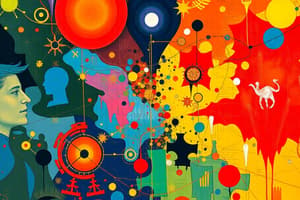Podcast
Questions and Answers
Which of the following is the primary reason economists make assumptions when developing models?
Which of the following is the primary reason economists make assumptions when developing models?
- To make the real world more complex and harder to analyze.
- To ensure that economic models are always perfectly accurate.
- To simplify reality and improve our understanding of it. (correct)
- To make their models more impressive to other economists.
In the circular-flow diagram, what is being exchanged between households and firms in the markets for goods and services?
In the circular-flow diagram, what is being exchanged between households and firms in the markets for goods and services?
- Capital for profit.
- Goods and services for revenue. (correct)
- Labor for wages.
- Rent for land.
Which of the following best describes the role of economic models?
Which of the following best describes the role of economic models?
- To provide a complete and exhaustive representation of reality.
- To perfectly predict future economic events with certainty.
- To advocate for specific political or social agendas.
- To simplify complex situations to improve our understanding. (correct)
An economist is asked to analyze the effects of a new tax on consumer spending. What should be her first step, according to the scientific method?
An economist is asked to analyze the effects of a new tax on consumer spending. What should be her first step, according to the scientific method?
Which of the following is an example of thinking like an economist?
Which of the following is an example of thinking like an economist?
In the circular flow diagram, which of the following transactions occurs in the markets for factors of production?
In the circular flow diagram, which of the following transactions occurs in the markets for factors of production?
According to the circular-flow diagram, what is the relationship between firms and households?
According to the circular-flow diagram, what is the relationship between firms and households?
In the circular-flow diagram, if there is an increase in household spending on goods and services, what is the most direct effect that would follow?
In the circular-flow diagram, if there is an increase in household spending on goods and services, what is the most direct effect that would follow?
How would a significant technological advancement that increases firms' productivity affect the circular flow diagram?
How would a significant technological advancement that increases firms' productivity affect the circular flow diagram?
If many workers shift from being employed by firms to starting their own businesses, how would this change be represented in the circular flow diagram?
If many workers shift from being employed by firms to starting their own businesses, how would this change be represented in the circular flow diagram?
Flashcards
Economic Thinking
Economic Thinking
Thinking in terms of alternatives and evaluating the costs of choices.
Economist as Scientist
Economist as Scientist
Thinking analytically and objectively, using the scientific method to understand the economy.
Economic Models
Economic Models
Abstract representations used to explain how the complex, real world operates.
Economic Assumptions
Economic Assumptions
Signup and view all the flashcards
Circular-Flow Diagram
Circular-Flow Diagram
Signup and view all the flashcards
Firms
Firms
Signup and view all the flashcards
Households
Households
Signup and view all the flashcards
Markets for Goods and Services
Markets for Goods and Services
Signup and view all the flashcards
Factors of Production
Factors of Production
Signup and view all the flashcards
Study Notes
Thinking Like an Economist
- Every field of study has its own terminology, for example, Mathematics includes integrals axioms vector spaces.
- Psychology includes ego id cognitive dissonance, Law includes promissory estoppel torts venues and Economics includes supply opportunity cost elasticity consumer surplus demand comparative advantage deadweight loss.
- Economics trains individuals to think in terms of alternatives, evaluate the cost of individual and social choices, and examine and understand how certain events and issues relate.
The Economist as a Scientist
- The economic way of thinking means thinking analytically and objectively, and makes use of the scientific method.
- Economists use abstract models to help explain how a complex, real world operates.
- Economists develop theories, collect and analyze data to evaluate the theories.
- Economists make assumptions to make the world easier to understand
- The art in scientific thinking is deciding which assumptions to make, and use different assumptions to answer different questions.
Economic Models
- These are used to simplify reality in order to improve our understanding of the world.
- Two of the most basic economic models include the Circular Flow Diagram and the Production Possibilities Frontier.
The Circular-Flow Diagram
- It's a visual model of the economy that shows how dollars flow through markets among households and firms.
- Firms produce and sell goods and services as well as hire and use factors of production.
- Households buy and consume goods and services and own and sell factors of production.
- Markets for Goods and Services: firms sell, households buy.
- Markets for Factors of Production: households sell, firms buy.
- Factors of Production are inputs, like land, labor, and capital, used to produce goods and services.
The Production Possibilities Frontier
- This graph illustrates the combinations of output that the economy can possibly produce given the available factors of production and the available production technology.
- Concepts illustrated by the Production Possibilities Frontier include:
- A= Efficiency
- B= Tradeoffs
- C= Opportunity Cost
- D= Economic Growth
Microeconomics and Macroeconomics
- Microeconomics focuses on the individual parts of the economy.
- Macroeconomics looks at the economy as a whole
- Unemployment, Inflation, Income of a consumer, Study of a firm, Price of a good, National Income
The Economist as Policy Advisor
- When economists are trying to explain the world, they are scientists.
- When economists are trying to change the world, they are policy advisors.
Positive Versus Normative Analysis
- Positive statements are statements that attempt to describe the world as it is (descriptive analysis).
- Example: An increase in the minimum wage will cause a decrease in employment among the least-skilled.
- Example: Higher federal budget deficits will cause interest rates to increase.
- Normative statements are statements about how the world should be (prescriptive analysis).
- The income gains from a higher minimum wage are worth more than any slight reductions in employment is an example.
- A second examples is State governments should be allowed to collect from tobacco companies the costs of treating smoking-related illnesses among the poor.
Economists in Washington
- They serve as advisers in the policymaking process of the three branches of government: Legislative, Executive, and Judicial.
- Some government agencies that collect economic data and make economic policy include the Department of Commerce, Bureau of Labor Statistics, Congressional Budget Office, and Federal Reserve Board.
Why Economists Disagree
- They may disagree about the validity of alternative positive theories about how the world works.
- They may have different values and, therefore, different normative views about what policy should try to accomplish.
- Ten Propositions about Which Most Economists Agree include:
- A ceiling on rents reduces the quantity and quality of housing available (93%)
- Tariffs and import quotas usually reduce general economic welfare (93%)
- Flexible and floating exchange rates offer an effective international monetary arrangement (90%)
- Fiscal policy has a significant stimulative impact on a less than fully employed economy (90%)
- If the federal budget is to be balanced, it should be done over the business cycle rather than yearly (85%)
- Cash payments increase the welfare of recipients to a greater degree than do transfers-in-kind of equal cash value (84%)
- A large federal budget deficit has an adverse effect on the economy (83%)
- A minimum wage increases unemployment among young and unskilled workers (79%)
- The government should restructure the welfare system along the lines of a "negative income tax" (79%)
- Effluent taxes and marketable pollution permits represent a better approach to pollution control than imposition of pollution ceilings (78%)
Summary Points
- Economics is divided into two subfields: Microeconomics and Macroeconomics.
- Microeconomists study decision-making by households and firms in the marketplace.
- Macroeconomists study the forces and trends that affect the economy as a whole.
- A positive statement is an assertion about how the world is.
- A normative statement is an assertion about how the world ought to be.
- When economists make normative statements, they are acting more as policy advisors than scientists.
- Economists who advise policymakers offer conflicting advice either because of differences in scientific judgments or because of differences in values.
- At other times, economists are united in the advice they offer, but policymakers may choose to ignore it.
Studying That Suits You
Use AI to generate personalized quizzes and flashcards to suit your learning preferences.




